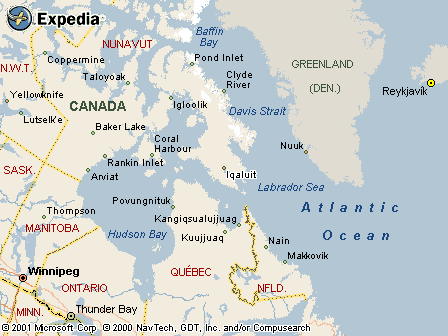|
 For
the first time, Greenland and Nunavut will host Arctic Winter
Games, the largest sports and cultural event in the Arctic region.
Almost 2,000 athletes will meet to compete, form contacts and
make friends across the boundaries of nationality and culture.
However, the host towns of Iqaluit and Nuuk also have another
mission: to show that we are a high tech part of the global community,
capable of organising international events of high standards. For
the first time, Greenland and Nunavut will host Arctic Winter
Games, the largest sports and cultural event in the Arctic region.
Almost 2,000 athletes will meet to compete, form contacts and
make friends across the boundaries of nationality and culture.
However, the host towns of Iqaluit and Nuuk also have another
mission: to show that we are a high tech part of the global community,
capable of organising international events of high standards.
This year, Canadian, Alaskan, Russian
and Greenlandic youth will meet for one week of events that will
outshine all prior events in Greenland and Northern Canada. Arctic
Winter Games is the event of the Arctic and all sails have been
set to make this the most spectacular event Greenland and Nunavut
have ever hosted.
Sound concepts behind
a fine tradition
In 1970 in Yellowknife, Canada 500 athletes, trainers and officials
came together for the first Arctic Winter Games. The participants
came from Northwest Territories, Yukon and Alaska. Since then,
the Games have been held on 15 occasions in different places and
with ever more participants from more and more places within the
Arctic region. At the 2002 Games there will be as many as 2000
participants in Nuuk and Iqaluit from Magadan, Chukotka, Alaska,
Yukon, Northern Alberta, Northwest Territories, Nunavik, Nunavut
and Greenland.
The basic elements in Arctic Winter
Games are sports, culture and friendship. This is symbolised in
the emblem of the Games - three rings against the background of
the northern lights. What unites the three elements is the desire
for fellowship, unity and co- operation between people. Fair play,
loyalty, friendship and respect are also among the basic values
of the Games.
The key to success
The key to success is first and foremost the active involvement
of a large number of people. Roughly 1,500-2,000 volunteers will
come to work on tasks of all sizes at the Arctic Winter Games.
Never before have so many people been asked to sign up for voluntary
duties in Nuuk and Iqaluit.
It is a great responsibility for the
relatively young countries to organise the Arctic Winter Games.
However, Arctic Winter Games is seen as an investment rather than
an expense - an investment in international co-operation, an investment
in youth and in our societies in general. It is an investment
in our future.
The sports
Arctic Winter Games comprises a large number of sports, some of
which are known all over the world, while others are specific
to the Arctic region. The indoor and outdoor sports facilities
at Nuuk will provide the setting for the following competitions:
alpine skiing, cross country skiing, snowboarding, snowshoeing,
badminton, indoor soccer, table tennis, volleyball, and Arctic
sports (Inuit and Dene games).
The indoor and outdoor sports facilities
at Iqaluit will provide the setting for the following competitions:
Arctic Sports (Inuit and Dene games), basketball, curling, dog
mushing, gymnastics, hockey, short track speedskating, and wrestling.
Arctic sports
The traditional Inuit games and Dene games unite sport and culture,
past and present. The old games have been passed down through
generations and are still very popular. The characteristics of
many of these games are that they take the form of an entertaining
contest between two people. The contests focus on strength, concentration,
co-ordination and flexibility: abilities that have always been
crucial for survival in the Arctic climate.
A showcase of the Arctic
culture
Culture is what we have in common and unites us to come together
across the borders. We will have the largest cultural program
ever in the history of the Games. You will see the culture that
is alive in our societies, with both traditional and contemporary
arts and performances from across the Arctic. In both Nuuk and
Iqaluit, the entire community will join to host cultural activities
of all kinds, such as the cultural Gala, art exhibitions, Arctic
film festivals, daytime and evening concerts, fashion shows, igloo
villages and much more.
|

 For
the first time, Greenland and Nunavut will host Arctic Winter
Games, the largest sports and cultural event in the Arctic region.
Almost 2,000 athletes will meet to compete, form contacts and
make friends across the boundaries of nationality and culture.
However, the host towns of Iqaluit and Nuuk also have another
mission: to show that we are a high tech part of the global community,
capable of organising international events of high standards.
For
the first time, Greenland and Nunavut will host Arctic Winter
Games, the largest sports and cultural event in the Arctic region.
Almost 2,000 athletes will meet to compete, form contacts and
make friends across the boundaries of nationality and culture.
However, the host towns of Iqaluit and Nuuk also have another
mission: to show that we are a high tech part of the global community,
capable of organising international events of high standards.